Quartz: Crystals Colors and Types (Photos)
One of the most abundant minerals on Earth is quartz, and it boasts a range of colors and forms. This versatile mineral can actually crystallize into large, visible structures called crystalline quartz. These crystals often exhibit well-defined geometric shapes, like hexagonal prisms.
Examples of crystalline quartz include the clear rock crystal, the purple amethyst, the yellow citrine, and the rose quartz. The presence of tiny amounts of other minerals during crystal formation creates the color variations, making each crystal unique. Additionally, quartz can exist in a microcrystalline form, where the crystals are too small to see individually. Examples of microcrystalline quartz include chalcedony, which can be found in a variety of colors, and agate, known for its banded appearance.
Quartz (SiO₂) silicon dioxide crystallizes in the trigonal crystal system and exhibits a wide range of physical and chemical properties that contribute to its ubiquity and extensive utilization.
Quartz is a key component of igneous, metamorphic, and sedimentary rocks. In igneous rocks, it is prevalent in felsic varieties such as granite, rhyolite, and pegmatite. Metamorphic processes can transform pre-existing minerals into quartz, leading to the formation of quartzite, a rock nearly entirely composed of quartz. Due to its exceptional durability, quartz persists through weathering and erosion, becoming a significant constituent of sedimentary rocks like sandstone and conglomerate. It's no surprise then that quartz comes in a staggering array of colors and forms, thanks to the presence of various impurities and inclusions.
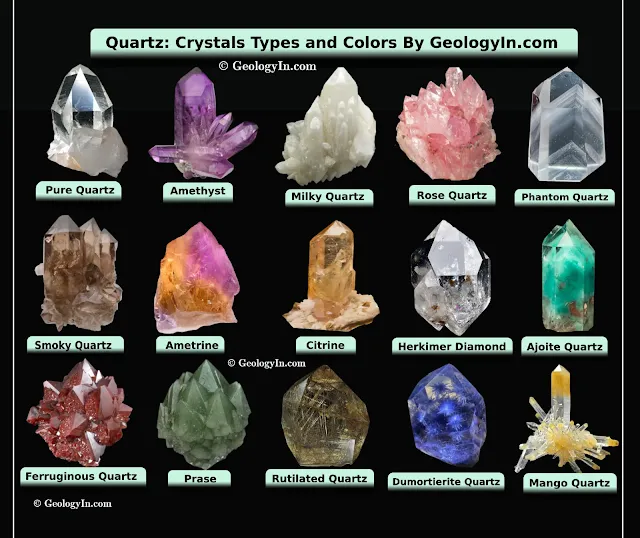 |
| Quartz: Crystals Colors and Types |
Quartz Properties
Here's a comprehensive exploration of its key properties:
Composition: SiO₂ (Silicon Dioxide) Quartz is a simple yet remarkable mineral composed entirely of silicon dioxide molecules arranged in a continuous, three-dimensional network.
Physical Properties
- Color: Colorless, gray, white, purple, yellow, brown, black, and many other colors (depending on impurities)
- Transparency: Transparent, translucent, opaque, Quartz can betransparent, allowing light to pass through freely, like clear rock crystal. It can also be translucent, permitting some light passage but blurring vision, or even opaque, completely blocking light transmission, as seen in milky quartz.
- Luster: Vitreous (glassy), greasy, waxy
- Crystal System: Trigonal
- Streak: White, When a mineral is scratched against a streak plate, it leaves behind a colored powder. Quartz has a white streak, regardless of its own body color. This is a valuable diagnostic feature for mineral identification.
- Hardness: 7 (Mohs scale)
- Cleavage: Absent, Cleavage describes a mineral's tendency to break along specific planes of weakness. Quartz exhibits no cleavage
- Fracture: Conchoidal (smooth, curved surfaces)
- Habit: Prismatic (elongated hexagonal prisms), massive, granular, The crystal habit describes the typical shapes a mineral forms. Quartz crystals commonly display a prismatic habit, characterized by elongated, six-sided prisms that may terminate in pointed ends. However, quartz can also occur in massive (shapeless chunks), granular (composed of tiny grains), or botryoidal (grape-like clusters) forms.
- Density: 2.65 g/cm³, Density refers to the mass per unit volume of a substance. Quartz has a density of around 2.65 grams per cubic centimeter (g/cm³).
- Tenacity: Brittle (breaks into irregular pieces)
- Solubility: Insoluble in water, slightly soluble in hydrofluoric acid
- Magnetism: Non-magnetic
Optical Properties
- Fluorescence: Can be weak to strong, various colors (depending on variety). Fluorescence is the property of a mineral to emit light of a different color when exposed to ultraviolet radiation. Some quartz varieties exhibit weak to strong fluorescence in various colors, adding another dimension to their visual appeal.
- Pleochroism: Can be weak to strong (appears to change color with viewing direction)
- Refractive Index: 1.544 - 1.553, The refractive index is a measure of how light bends as it passes through a material. Quartz has a refractive index ranging from 1.544 to 1.553. This property is crucial for applications like lenses and prisms, where light refraction plays a vital role.
Additional Properties
- Inclusions: Many quartz varieties contain inclusions of other minerals within their crystal structure. These inclusions can influence the overall appearance of the quartz, sometimes creating visually striking effects. For instance, rutilated quartz features needle-like inclusions of rutile, a titanium dioxide mineral, that add a golden sheen or hair.
- Piezoelectric: Quartz exhibits a unique property called piezoelectricity. When pressure is applied to a quartz crystal, it generates a small electric current. Conversely, applying an electric current can cause the crystal to vibrate. This property has numerous applications in electronics, such as in oscillators, timers, and pressure sensors.
- Heat Resistant: Quartz has a high melting point (1670 °C - 1713 °C ). making it resistant to high temperatures. This property makes it suitable for use in crucibles for melting metals and other high-heat applications.
- Chemically Inert: Quartz is chemically inert, meaning it doesn't readily react with most substances. This makes it ideal for use in containers for storing various chemicals or corrosive materials.
- Associated Minerals: Often found with feldspar, mica, pyrite, hematite, calcite (depending on geological environment)
Quartz Colors
In its pure state, quartz is colorless. However, tiny impurities trapped within the crystal structure during formation can cause a wide range of colors. These impurities affect the way light interacts with the quartz, creating different wavelengths of light that are absorbed or reflected, resulting in the perceived color we see.
- Amethyst: This beautiful purple quartz is colored by trace amounts of iron (Fe³⁺).
- Citrine: This yellow or orange quartz gets its color from ferric iron (Fe³⁺) substituting for silicon ions in the crystal lattice.
- Smoky quartz: This smoky gray or brown quartz is colored by natural radiation exposure.
- Milky quartz: This white quartz gets its cloudy appearance from microscopic fluid inclusions, tiny gas bubbles, or both, trapped within the crystal during formation.
- Rose Quartz: This soft pink or rose-colored quartz is colored by tiny inclusions of manganese (Mn²⁺) sometimes along with titanium (Ti ⁴⁺) .
Quartz Crystals Colorful World
Crystalline quartz offers a spectrum of beauty, from the clarity of rock crystal to the violet hues of amethyst, the sunshine yellow of citrine, the soft pink of rose quartz, and even the captivating bi-colored ametrine.
Here are the types of macrocrystalline quartz:
Colorless Quartz - Pure Quartz
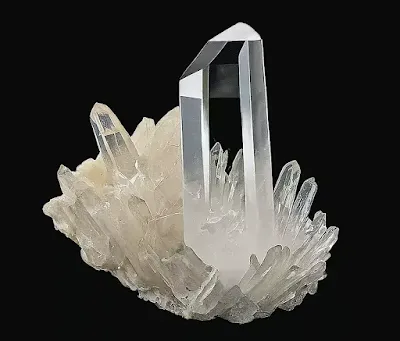 |
| Rock Crystal - clear Quartz crystal |
Rock Crystal also known as clear quartz, rock crystal is the purest form of quartz, known for its exceptional clarity and colorless appearance. It allows light to pass through it almost perfectly, making it valuable for various applications. Rock crystal has been used throughout history for tools, jewelry, and decorative objects. Today, it's still used in various applications, including
- Electronics: Due to its piezoelectric properties, which convert pressure into electrical signals, rock crystal is used in various electronic components like oscillators and filters.
- Optics: Rock crystal's clarity makes it ideal for lenses and prisms in scientific instruments and some high-end optical devices.
- Jewelry: When cut and polished, rock crystal can be a beautiful gemstone used in jewelry.
Amethyst - Purple Quartz
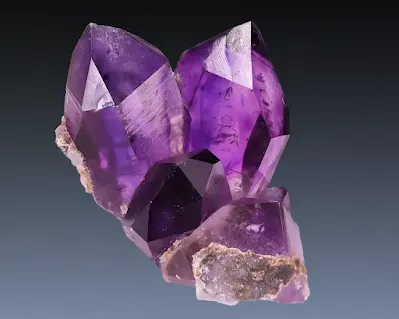 |
Amethyst crystals from Goboboseb Mtns., Brandberg area, Erongo, Namibia |
Amethyst is a purple variety of quartz. This captivating quartz comes in various shades of violet, from light lavender to deep purple. The color is caused by trace amounts of iron and manganese. The quality and value of amethyst can vary depending on several factors, including color saturation, clarity, and presence of inclusions. Amethyst typically forms elongated crystals with pyramids on the ends, but it can also be found in clusters, scepters, or druzy masses. Amethyst can be found in many parts of the world, including Brazil, Uruguay, Siberia, South Africa, and North America. Some of the most famous amethyst deposits are in Uruguay. Amethyst is a popular gemstone, sought after for its beauty and believed to have calming properties.
Rose Quartz - Pink Quartz
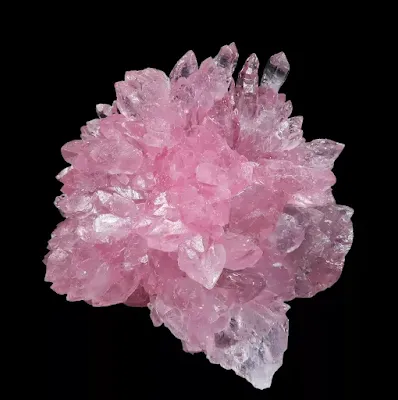 |
Rose Quartz from Alto da Pitorra, Laranjeiras, Galileia, Minas Gerais, Brazil |
Rose quartz is a pink variety of quartz that gets its color from trace amounts of titanium and manganese. Rose quartz ranges in color from pale pink to deep rose. The most desirable rose quartz has a soft, even saturation of color. Rose quartz can be found in many parts of the world, including Brazil, Madagascar, India, Sri Lanka, and the United States. Some of the most famous rose quartz deposits are in Brazil. Rose quartz is a popular gemstone for jewelry and carvings, often associated with love, peace, and emotional healing.
Milky Quartz - White Quartz
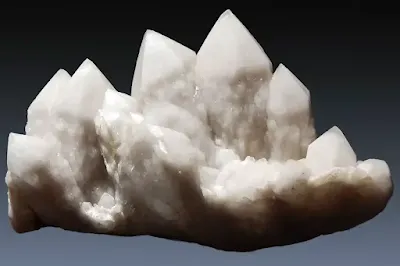 |
| Milky Quartz, Candle quartz |
Milky quartz is a type of quartz that has a cloudy or milky appearance due to tiny air bubbles or water droplets trapped within the crystal. Milky quartz can range in color from white to grayish-white to creamy white. It is not transparent and can be translucent or opaque. Milky quartz is found all over the world. Some of the most notable locations include Brazil, Madagascar, India, and the United States. It's not as commonly used for jewelry as other varieties but can be found in carvings or used for its believed metaphysical properties.
Smoky Quartz - Brown/Black Quartz
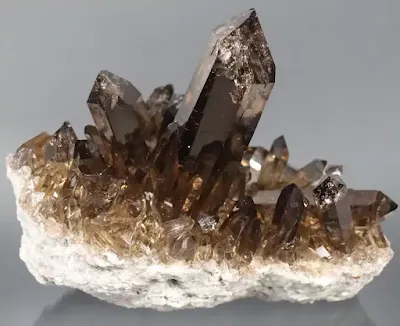 |
Smoky Quartz Cluster from Göschener Alp in Uri, Switzerland. |
Smoky Quartz is a type of quartz known for its smoky gray or brown color caused by natural irradiation from surrounding rocks containing radioactive elements. The intensity of the smoke color can vary greatly, ranging from a light haze to an almost opaque black. Smoky quartz is a popular gemstone used in jewelry making and other decorative objects. Smoky quartz is one of the most common gemstones and can be found in many parts of the world, including Brazil, Switzerland, Madagascar, Scotland, India, Nepal, and the United States. It's also believed to have metaphysical properties, including grounding, stability, dispelling negativity, and promoting emotional well-being.
Citrine - Yellow Quartz
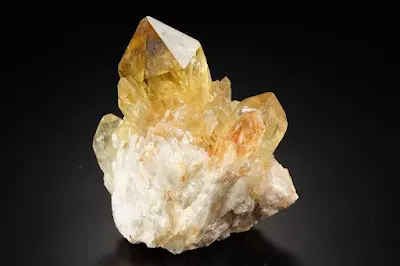 |
| Natural citrine cluster |
Citrine is a stunning variety of quartz known for its vibrant yellow to golden-brown hues. Citrine is a transparent gemstone formed by natural heat treatment of amethyst or smoky quartz, or by the presence of trace amounts of ferric iron within the crystal structure itself. Natural citrine is quite rare, with most commercially available citrine being heat-treated. Some notable sources include Brazil (Rio Grande do Sul), Madagascar, Uruguay. Citrine is often referred to as the "Merchant's Stone" due to its association with abundance, prosperity, and success. It's a popular gemstone widely used in jewelry and decorative objects.
Ferruginous Quartz - Red Quartz
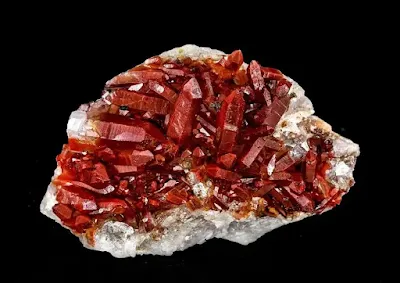 |
| Red quartz from Tinejdad, Errachidia Province, Drâa-Tafilalet Region, Morocco |
Ferruginous quartz is a variety of quartz that gets its reddish-brown or yellow color from inclusions of iron oxides, most commonly hematite or limonite. It's typically opaque, but can sometimes be translucent. The color of ferruginous quartz varies depending on the type and amount of iron oxide inclusions. It can range from a light brownish-red to a deep, rusty brown. Ferruginous quartz is found worldwide in hydrothermal veins, sedimentary rocks near iron ore deposits, or weathered zones. Some common locations include China, Morocco, Canada, France, Czech Republic, and the United States.
Prase - Green Quartz
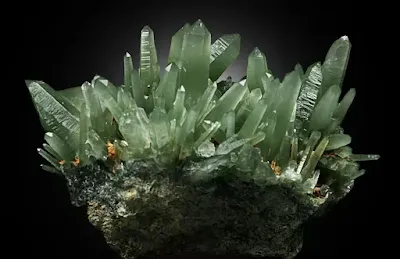 |
| Prase - Green Quartz from Porticciolo, Rio Marina, Rio, Livorno Province, Tuscany, Italy Photo: Fernando Metelli |
Prase is a variety of quartz distinguished by its distinctive green color. This green hue arises from microscopic inclusions of other minerals like actinolite (amphibole) or chlorite trapped within the quartz crystal structure. Prase exhibits a range of green colors, varying from a pale, almost milky green to a deep, vibrant emerald green. Prase is not as common as other quartz types but is still used in jewelry and carvings. Prase is found worldwide. Look for it in Europe (Germany, Italy, Switzerland, France) and Greece (Serifos Island). It's sometimes referred to as "Green Quartz" and is believed to have metaphysical properties associated with peace, tranquility, and emotional healing.
Herkimer Diamond
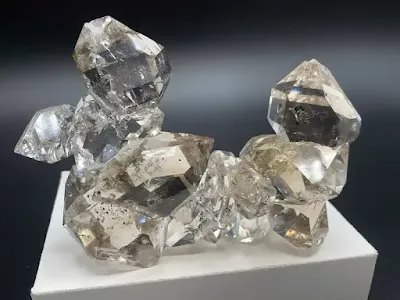 |
| Herkimer Diamond, quartz from The Herkimer Diamond Mines KOA, Middleville, New York |
Herkimer Diamond This quartz variety isn't actually a diamond but beautiful double-terminated (points at both ends) quartz crystals found primarily in Herkimer County, New York. They are known for their exceptional clarity, high luster, and short, stubby crystals. These quartz crystals can be transparent, smoky, or have inclusions of carbon, goethite, or rutile. Herkimer diamonds are popular gemstones used in jewelry and are believed to have metaphysical properties associated with amplification of energy and spiritual connection.
Ametrine
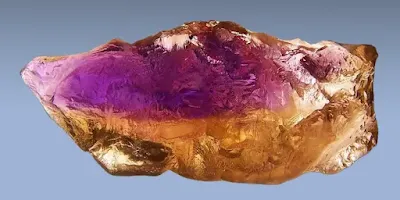 |
| Natural ametrine crystal from Anahi Mine, Santa Cruz Department, Bolivia |
Ametrine is a naturally occurring bicolor quartz that combines zones of amethyst (violet) and citrine (yellow or orange). The color zoning can range from vibrant yellow to deep orange tones seamlessly blending into violet or lavender hues. Ametrine is not as common as other quartz types but is a highly sought-after gemstone prized for its beauty and rarity. Ametrine comes from a single location, The Ametrine Mines of Anahi, Bolivia. It's often used in jewelry and believed to have metaphysical properties associated with creativity, balance, and emotional well-being.
Rutilated Quartz
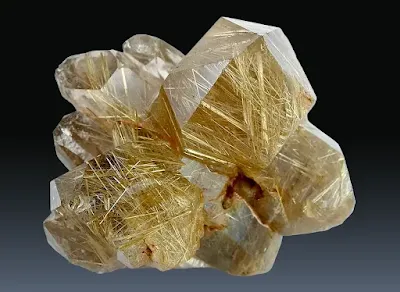 |
| Rutilated Quartz cluster from Serra Mangabeira, Bahia, Brazil. |
Rutilated Quartz is a variety of quartz features inclusions of needle-like or hair-like crystals of rutile, a titanium dioxide mineral. These inclusions can be golden yellow, red, brown, or black, creating a beautiful contrast within the quartz crystal. Rutilated quartz can be found in many parts of the world, including Brazil, Madagascar, the United States, Russia. Rutilated quartz is a popular gemstone used in jewelry, sometimes referred to as "Venus Hair Stone" due to the golden rutile needles resembling hair. It's believed to have metaphysical properties associated with strength, creativity, and spiritual growth.
Dumortierite Quartz
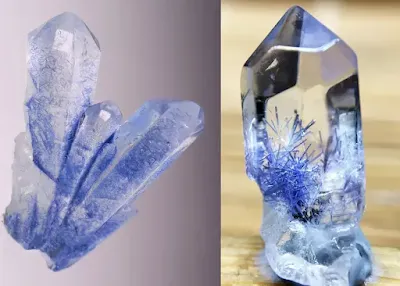 |
| Dumortierite Quartz from Vaca Morta quarry, Serra da Vereda, Boquira, Bahia, Brazil |
Dumortierite quartz is a type of quartz that contains inclusions of dumortierite, a mineral with a beautiful blue or violet color. These inclusions often appear fibrous or hair-like, giving the quartz a distinctive appearance. Dumortierite quartz is considered a rare gemstone compared to rutilated quartz. Some sources include: Madagascar, Brazil, Namibia. Due to its relative rarity, dumortierite quartz is prized by collectors and can be used in high-end jewelry creations like rings, pendants, or earrings. It can also be carved or polished for decorative purposes. It's believed to promote peace, patience, and organization.
Ajoite Quartz
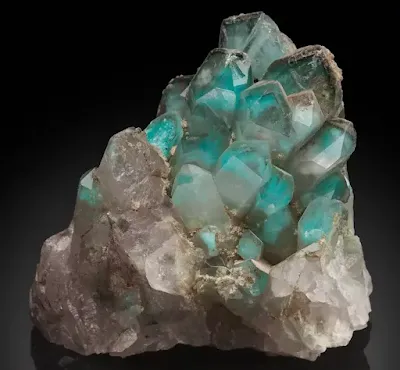 |
| Ajoite in Quartz. Shaft, Messina Mine, Musina, Vhembe District, Limpopo Province, South Africa |
Ajoite quartz is a relatively rare variety of quartz that features inclusions of a turquoise-colored mineral called ajoite. These inclusions can be wispy, clustered, or veined, creating a beautiful contrast within the quartz crystal. Ajoite quartz almost exclusively found in the Messina Mine located in Limpopo Province, South Africa. Due to its rarity, ajoite quartz is not commonly faceted into gemstones, but it's gaining popularity among collectors and enthusiasts for its unique aesthetic. Ajoite quartz often sought after for its calming and nurturing energy. Believed to promote feelings of love, peace, and spiritual connection.
Phantom Quartz
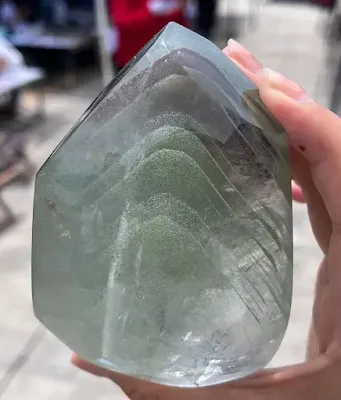 |
| Phantom Quartz |
Phantom quartz is a variety of quartz that contains visible layers of overlapping crystal formations. These layers, or phantoms, are caused by interruptions in the crystal's growth process. Phantom quartz can be found in various colors, depending on the type of quartz it forms with (clear, smoky quartz, amethyst, etc.). Notable locations include Brazil, Madagascar, India, and the US. Many believe phantom quartz holds properties for personal growth, overcoming challenges, and connecting with past experiences.
Quartz Uses
Quartz, the second most abundant mineral on Earth, boasts a surprising variety of uses due to its unique properties. Here's a breakdown of its key applications:
Glassmaking: The major use of quartz is in glass production. Quartz sand, silicon dioxide (SiO₂), is the main ingredient for various types of glass, including container glass, windows, specialty glass, and even fiberglass.
Electronics: The piezoelectric property of quartz crystals, where pressure creates a voltage and vice versa, makes them crucial for precise timing. They are used in crystal oscillators found in watches, clocks, radios, computers, and GPS devices.
Jewelry and Gemstones: Certain varieties of quartz are valued gemstones. Amethyst, citrine, rose quartz, and smoky quartz are popular choices, prized for their beauty and durability. Even clear quartz can be faceted into stunning jewelry pieces.
Construction Materials: Crushed quartz finds use in various construction materials. Quartz sand is used in concrete, paints, and adhesives for its strength and abrasive nature. Sandstone, a rock largely composed of quartz grains, is used for building materials and sculpting.
Other Uses: Quartz has various other applications:
- Foundry and Refractory Industries: Quartz sand's heat resistance makes it ideal for molds and cores in metal casting and refractory bricks for high-temperature applications.
- Sandblasting and Abrasives: Crushed quartz is used for sandblasting and as an abrasive in sandpaper due to its hardness.
- Laboratory Equipment: Highly pure quartz, called fused quartz, transmits ultraviolet light well and is used for laboratory crucibles, tubes, and optical lenses.
- Fillers: Finely ground quartz can be used as a filler in various products like toothpaste and some paints.
Overall, quartz's versatility makes it a vital material across numerous industries.
Quartz also has a whole other category called cryptocrystalline quartz, which has microcrystalline structures. These types of quartz are usually opaque or translucent, and come in a wide variety of colors and forms. Like chalcedony, agate, jasper, carnelian, bloodstone, chrysoprase, Cat's Eye, Sard, and Venturine. Read about it here.


%20(1).webp)





